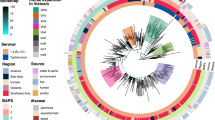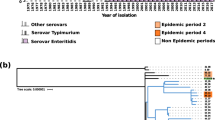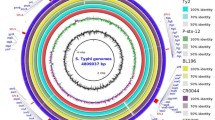Abstract
DT104 emerged as a new branch of Salmonella typhimurium with resistance to multiple antimicrobials. To reveal some general genomic features of DT104 for clues of evolutionary events possibly associated with the emergence of this relatively new type of this pathogen, we mapped 11 independent DT104 strains and compared them with non-DT104 S. typhimurium strains. We found that all 11 DT104 strains contained three insertions absent in non-DT104 strains, i.e., the previously reported ST104, ST104B and ST64B. However, SGI-1, a genomic island known to be responsible for DT104 multidrug resistance, was not present in all DT104 strains examined in this study: one DT104 strain did not contain SGI-1 but carried a 144 kb plasmid, suggesting possible evolutionary relationships between the two DNA elements in the development of antimicrobial resistance.



Similar content being viewed by others
References
Boyd D, Peters GA, Cloeckaert A, Boumedine KS, Chaslus-Dancla E, Imberechts H, Mulvey MR (2001) Complete nucleotide sequence of a 43-kilobase genomic island associated with the multidrug resistance region of Salmonella enterica serovar Typhimurium DT104 and its identification in phage type DT120 and serovar Agona. J Bacteriol 183(19):5725–5732
Chiu CH, Tang P, Chu C, Hu S, Bao Q, Yu J, Chou YY, Wang HS, Lee YS (2005) The genome sequence of Salmonella enterica serovar Choleraesuis, a highly invasive and resistant zoonotic pathogen. Nucleic Acids Res 33(5):1690–1698
Cooke FJ, Brown DJ, Fookes M, Pickard D, Ivens A, Wain J, Roberts M, Kingsley RA, Thomson NR, Dougan G (2008) Characterization of the genomes of a diverse collection of Salmonella enterica serovar Typhimurium definitive phage type 104. J Bacteriol 190(24):8155–8162
Crosa JH, Brenner DJ, Ewing WH, Falkow S (1973) Molecular relationships among the Salmonelleae. J Bacteriol 115(1):307–315
Fekete PZ, Nagy B (2008) Salmonella Genomic Island 1 (SGI1) and genetic characteristics of animal and food isolates of Salmonella typhimurium DT104 in Hungary. Acta Vet Hung 56(1):5–11
Feng DF, Cho G, Doolittle RF (1997) Determining divergence times with a protein clock: update and reevaluation. Proc Natl Acad Sci USA 94(24):13028–13033
Feng Y, Liu W-Q, Sanderson KE, Liu S-L (2011) Comparison of Salmonella genomes. In: Porwollik S (ed) Salmonella from genome to function. Caister Academic Press, Norfolk, pp 49–67
Glynn MK, Bopp C, Dewitt W, Dabney P, Mokhtar M, Angulo FJ (1998) Emergence of multidrug-resistant Salmonella enterica serotype typhimurium DT104 infections in the US. N Engl J Med 338(19):1333–1338
Helms M, Ethelberg S, Molbak K (2005) International Salmonella Typhimurium DT104 infections, 1992–2001. Emerg Infect Dis 11(6):859–867
Hermans AP, Abee T, Zwietering MH, Aarts HJ (2005) Identification of novel Salmonella enterica serovar Typhimurium DT104-specific prophage and non prophage chromosomal sequences among serovar Typhimurium isolates by genomic subtractive hybridization. Appl Environ Microbiol 71(9):4979–4985
Hermans AP, Beuling AM, van Hoek AH, Aarts HJ, Abee T, Zwietering MH (2006) Distribution of prophages and SGI-1 antibiotic-resistance genes among different Salmonella enterica serovar Typhimurium isolates. Microbiology 152(Pt 7):2137–2147
Kauffmann F, Edwards PR (1957) A revised, simplified Kauffmann–White schema. Acta pathologica et microbiologica Scandinavica 41(3):242–246
Kawagoe K, Mine H, Asai T, Kojima A, Ishihara K, Harada K, Ozawa M, Izumiya H, Terajima J, Watanabe H et al (2007) Changes of multi-drug resistance pattern in Salmonella enterica subspecies enterica serovar typhimurium isolates from food-producing animals in Japan. J Vet Med Sci 69(11):1211–1213
Le Minor L, Popoff MY (1987) Designation of Salmonella enterica sp. nov., nom. rev., as the type and only species of the genus Salmonella. Int J Syst Bacteriol 37:465–468
Liu SL (2007) Physical mapping of Salmonella genomes. In: Schatten H, Eisenstark A (eds) Methods in molecular biology. Methods and Protocols. Salmonella, vol 394, Humana Press Inc, Totowa, NJ, pp 39–58. ISBN:1064-3745
Liu SL, Sanderson KE (1992) A physical map of the Salmonella typhimurium LT2 genome made by using XbaI analysis. J Bacteriol 174(5):1662–1672
Liu SL, Sanderson KE (1995a) I-CeuI reveals conservation of the genome of independent strains of Salmonella typhimurium. J Bacteriol 177(11):3355–3357
Liu SL, Sanderson KE (1995b) Rearrangements in the genome of the bacterium Salmonella typhi. Proc Natl Acad Sci USA 92(4):1018–1022
Liu SL, Sanderson KE (1996) Highly plastic chromosomal organization in Salmonella typhi. Proc Natl Acad Sci USA 93(19):10303–10308
Liu SL, Hessel A, Sanderson KE (1993a) Genomic mapping with I-Ceu I, an intron-encoded endonuclease specific for genes for ribosomal RNA, in Salmonella spp. Escherichia coli, and other bacteria. Proc Natl Acad Sci USA 90(14):6874–6878
Liu SL, Hessel A, Sanderson KE (1993b) The XbaI-BlnI-CeuI genomic cleavage map of Salmonella typhimurium LT2 determined by double digestion, end labelling, and pulsed-field gel electrophoresis. J Bacteriol 175(13):4104–4120
Liu SL, Hessel A, Sanderson KE (1993c) The XbaI-BlnI-CeuI genomic cleavage map of Salmonella enteritidis shows an inversion relative to Salmonella typhimurium LT2. Mol Microbiol 10(3):655–664
Liu SL, Schryvers AB, Sanderson KE, Johnston RN (1999) Bacterial phylogenetic clusters revealed by genome structure. J Bacteriol 181(21):6747–6755
Liu GR, Rahn A, Liu WQ, Sanderson KE, Johnston RN, Liu SL (2002) The evolving genome of Salmonella enterica serovar Pullorum. J Bacteriol 184(10):2626–2633
Liu GR, Liu WQ, Johnston RN, Sanderson KE, Li SX, Liu SL (2006) Genome plasticity and ori-ter rebalancing in Salmonella typhi. Mol Biol Evol 23(2):365–371
Liu WQ, Feng Y, Wang Y, Zou QH, Chen F, Guo JT, Peng YH, Jin Y, Li YG, Hu SN et al (2009) Salmonella paratyphi C: genetic divergence from Salmonella choleraesuis and pathogenic convergence with Salmonella typhi. PLoS One 4(2):e4510
Marshall P, Lemieux C (1992) The I-CeuI endonuclease recognizes a sequence of 19 base pairs and preferentially cleaves the coding strand of the Chlamydomonas moewusii chloroplast large subunit rRNA gene. Nucleic Acids Res 20(23):6401–6407
Matiasovicova J, Adams P, Barrow PA, Hradecka H, Malcova M, Karpiskova R, Budinska E, Pilousova L, Rychlik I (2007) Identification of putative ancestors of the multidrug-resistant Salmonella enterica serovar typhimurium DT104 clone harboring the Salmonella genomic island 1. Arch Microbiol 187(5):415–424
McClelland M, Jones R, Patel Y, Nelson M (1987) Restriction endonucleases for pulsed field mapping of bacterial genomes. Nucleic Acids Res 15(15):5985–6005
McClelland M, Sanderson KE, Spieth J, Clifton SW, Latreille P, Courtney L, Porwollik S, Ali J, Dante M, Du F et al (2001) Complete genome sequence of Salmonella enterica serovar Typhimurium LT2. Nature 413(6858):852–856
Mmolawa PT, Schmieger H, Heuzenroeder MW (2003) Bacteriophage ST64B, a genetic mosaic of genes from diverse sources isolated from Salmonella enterica serovar typhimurium DT 64. J Bacteriol 185(21):6481–6485
Mulvey MR, Boyd DA, Olson AB, Doublet B, Cloeckaert A (2006) The genetics of Salmonella genomic island 1. Microbes Infect 8(7):1915–1922
Ochman H, Wilson AC (1987) Evolution in bacteria: evidence for a universal substitution rate in cellular genomes. J Mol Evol 26(1–2):74–86
Parkhill J, Dougan G, James KD, Thomson NR, Pickard D, Wain J, Churcher C, Mungall KL, Bentley SD, Holden MT et al (2001) Complete genome sequence of a multiple drug resistant Salmonella enterica serovar Typhi CT18. Nature 413(6858):848–852
Popoff MY (2001) Antigenic formulas of the Salmonella serovars, 8th edn. WHO Collaborating Center for Reference and Research on Salmonella, Paris
Popoff MY, Le Minor LE (2005) Genus XXXIII Salmonella. In: Brenner DJ, Krieg NR, Stanley JT (eds) Bergey’s mannual of systematic bacteriology, 2nd edn. Springer, Berlin, pp 764–799
Poppe C, Ziebell K, Martin L, Allen K (2002) Diversity in antimicrobial resistance and other characteristics among Salmonella typhimurium DT104 isolates. Microb Drug Resist 8(2):107–122
Reeves MW, Evins GM, Heiba AA, Plikaytis BD, Farmer JJ 3rd (1989) Clonal nature of Salmonella typhi and its genetic relatedness to other salmonellae as shown by multilocus enzyme electrophoresis, and proposal of Salmonella bongori comb. nov. J Clin Microbiol 27(2):313–320
Tanaka K, Nishimori K, Makino S, Nishimori T, Kanno T, Ishihara R, Sameshima T, Akiba M, Nakazawa M, Yokomizo Y et al (2004) Molecular characterization of a prophage of Salmonella enterica serotype Typhimurium DT104. J Clin Microbiol 42(4):1807–1812
Tang L, Liu SL (2012) The 3Cs provide a novel concept of bacterial species: messages from the genome as illustrated by Salmonella. Antonie Van Leeuwenhoek 101(1):67–72
Threlfall EJ, Frost JA, Ward LR, Rowe B (1994) Epidemic in cattle and humans of Salmonella typhimurium DT 104 with chromosomally integrated multiple drug resistance. Vet Rec 134(22):577
Weese JS, Baird JD, Poppe C, Archambault M (2001) Emergence of Salmonella typhimurium definitive type 104 (DT104) as an important cause of salmonellosis in horses in Ontario. Can Vet J 42(10):788–792
Yokoyama E, Maruyama S, Kabeya H, Hara S, Sata S, Kuroki T, Yamamoto T (2007) Prevalence and genetic properties of Salmonella enterica serovar typhimurium definitive phage type 104 isolated from Rattus norvegicus and Rattus rattus house rats in Yokohama city Japan. Appl Environ Microbiol 73(8):2624–2630
Yu CY, Chou SJ, Yeh CM, Chao MR, Huang KC, Chang YF, Chiou CS, Weill FX, Chiu CH, Chu CH, Chu C (2008) Prevalence and characterization of multidrug-resistant (type ACSSuT) Salmonella enterica serovar Typhimurium strains in isolates from four gosling farms and a hatchery farm. J Clin Microbiol 46(2):522–526
Acknowledgments
This work was supported by Genome Canada Grant 256177 to CP; a Grant of National Natural Science Foundation of China (NSFC31100134) to QHZ; a Grant of National Natural Science Foundation of China (NSFC30970078) and a Grant of Natural Science Foundation of Heilongjiang Province of China to GRL; a Heilongjiang Innovation Endowment Award for graduate studies (YJSCX2012-197HLJ) to LT; and Grants of the National Natural Science Foundation of China (NSFC30970119, 81030029, 81271786), a Grant of the National Natural Science Foundation of China and National Institutes of Health of USA (NSFC-NIH 81161120416), and a Specialized Research Fund for the Doctoral Program of Higher Education (SRFDP, 20092307110001) to SLL.
Conflict of interest
All authors have declared that no competing interests exist.
Author information
Authors and Affiliations
Corresponding authors
Additional information
Communicated by D. Ussery.
E.-Y. Zhao, H.-X. Bao, and L. Tang contributed equally to this work.
Rights and permissions
About this article
Cite this article
Zhao, EY., Bao, HX., Tang, L. et al. Genomic comparison of Salmonella typhimurium DT104 with non-DT104 strains. Mol Genet Genomics 288, 549–557 (2013). https://doi.org/10.1007/s00438-013-0762-8
Received:
Accepted:
Published:
Issue Date:
DOI: https://doi.org/10.1007/s00438-013-0762-8




